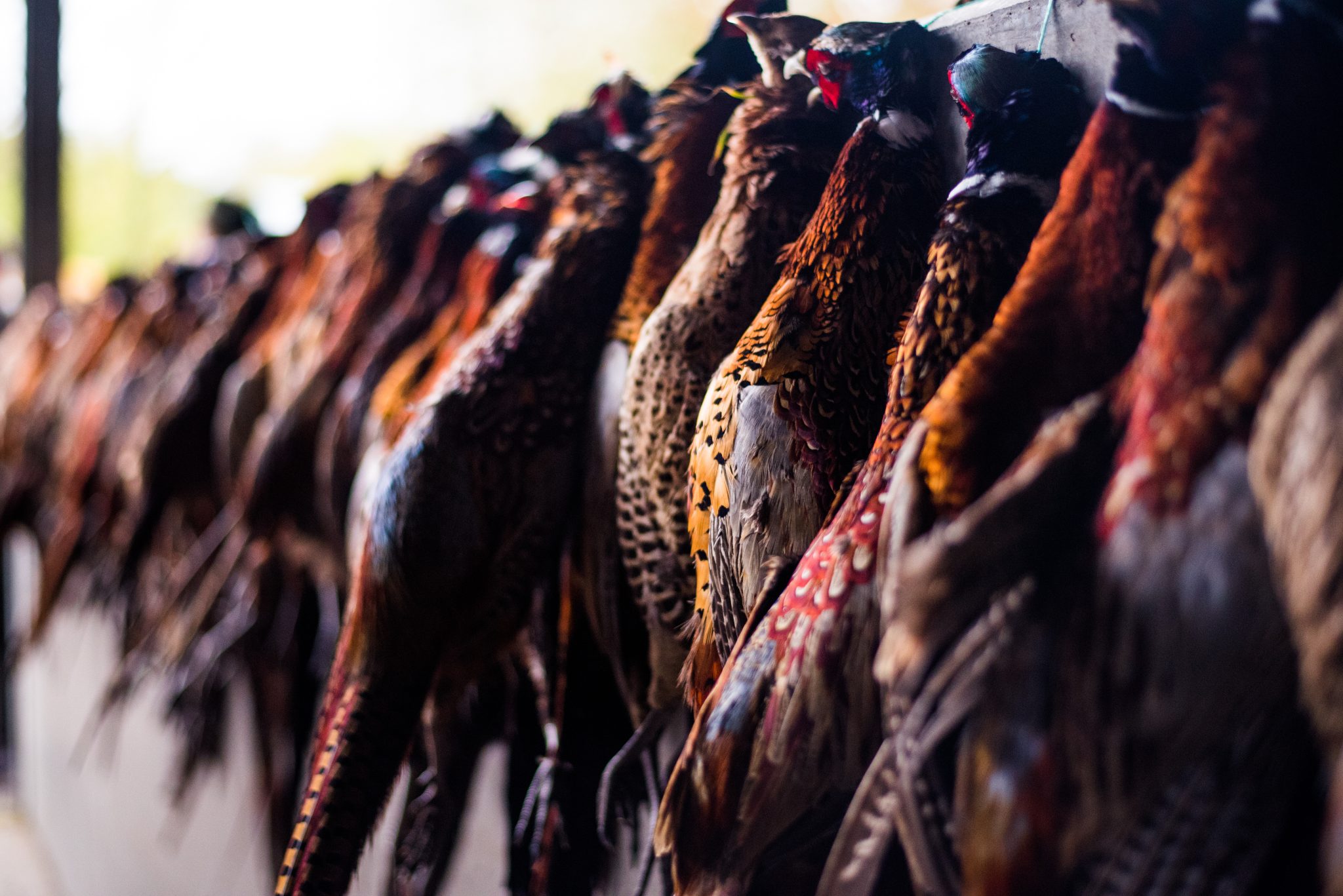Win CENS ProFlex DX5 earplugs worth £1,149 – enter here
Guns, beaters and pickers-up. All on an equal footing
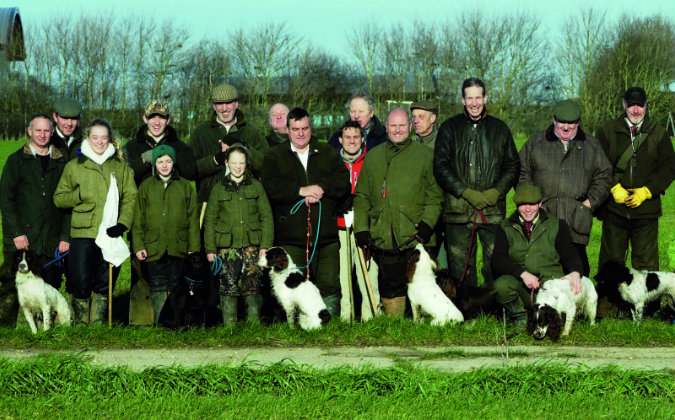
Whether we like it or not, most shoots have a distinct social order. It’s Guns first, then loaders (if there are any), pickers-up and finally beaters. It is a natural order, because (if you will excuse the pun) it’s usually the Guns that call the shots. However, it is always refreshing to find shoots where things are run differently, which is why I was delighted to receive an email from Jo Gosling, the field trial secretary of the Norfolk and Suffolk HPR Field Trial Club, who invited me along to the Grove, an Essex shoot now in its third season.
Not one person is any more important than the next
“We are a friendly group and not one person is any more important than the next,” said Jo, who organises the picking- up team, while her husband David runs the handlers and dogs in the beating team.
It sounded like the recipe for not only a good day out, but also an interesting article, so on a cold and frosty morning I wound my way through the lanes to the meet at West Bergholt, not far from Colchester. This was to be a special day, as a team of Guns had come over from Germany to enjoy some traditional English sport. I was introduced to the shoot’s founders, Miles Malone and Jochen Korves; Jochen had brought the German team over for the day.
Though several of the Guns had not shot in England before, others were regulars. To the delight of everyone present, two of the visitors played a salute to the day on their hunting horns before we moved off. The use of hunting horns is a traditional part of a day’s shooting in Germany, and adds greatly to the sense of occasion.
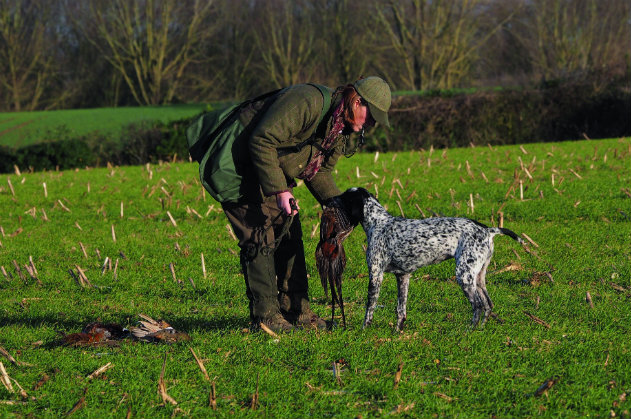
Jo Gosling takes a bird from her GSP bitch, Maisie
Vizslas and a Brittany
As you might expect, Jo’s picking-up team is made up chiefly of HPR handlers. Jo had her black-and-white ticked German shorthaired pointer (GSP) bitch, Maisie, plus her 18-month-old GSP Martha, which was out for experience rather than work. Andy Coveney was handling his Brittany, Harley, and Paul Keyland had a brace of Hungarian wirehaired vizslas. Both Stephen Pleasance and Will Witney were handling GSPs, and Peter Albon was working his Labrador Tilly.
The first drive was a long one, and it was some time before the first birds braved the Guns. This gave me time to chat to Andy Coveney, who said that though he had handled three-and-a-half year-old Harley on shoots on numerous occasions, this was the first time that they had been in a picking-up team.
Frustratingly, when Andy slipped Harley for his first retrieve of a running partridge, another bird swooped low in front of the Brittany, confusing the dog so that he lost his mark. It’s happened to us all, but the timing was unfortunate. I’m pleased to report that when I joined Andy later in the day, Harley had had several satisfactory retrieves.
The Grove covers almost 1,000 acres, and though much of the land is arable, there’s also some delightfully wild and rough ground adjoining a small stream that flows into the river Colne. Pheasants love damp ground like this, so the pickers-ups had the job of pushing birds out of this sanctuary and back into the drive. Here Stephen Pleasance’s brace of GSPs, Eva and Ghillie, came into their own, working beautifully and finding lots of birds. However, handling was essential because, being HPRs, the dogs preferred to point rather than just flush.
The Guns were clearly enjoying themselves enormously, and we were treated to more horn blowing when we stopped for sausage rolls after the third drive. Everyone was also given the opportunity to sample some fine German schnapps, courtesy of the Guns. It was just the job on a cold morning.
Spaniels all the way
After the break I took the opportunity to join the beating team. Beating is usually fun, and it was especially so with this convivial group. While HPRs may dominate the picking-up team, it was 100 per cent spaniels in the beating line. Several of the beaters compete with their dogs in trials, while others just come out for the fun of the day.
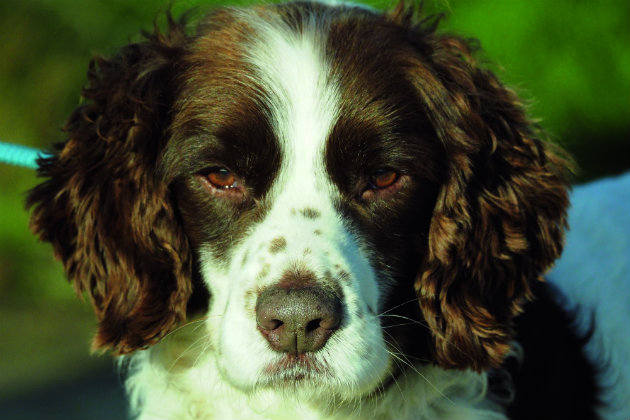
It was 13-year-old Blitz’s last day in the beating line
I gathered that one of the spaniels, a springer called Blitz, was older than several of the beaters. His owner, Bernie Connolly, told me that Blitz was now 13, and this was to be his very last day’s shooting. He had a good day to finish on.
While Blitz was concluding his shooting career, three-year-old Rafael Jefford
was just starting his. Accompanied by his father, Matt, he proved to be a keen and enthusiastic beater, waving his flag with gusto. Holly the English pointer accompanied Matt and Rafael.
Matt has done a remarkable job in training Holly, a working-bred rescue dog, and she has become an unlikely beating dog, showing great recall, except when seduced by a hare. Matt, who helps with the keepering on the shoot, told me that her speciality is dogging-in.
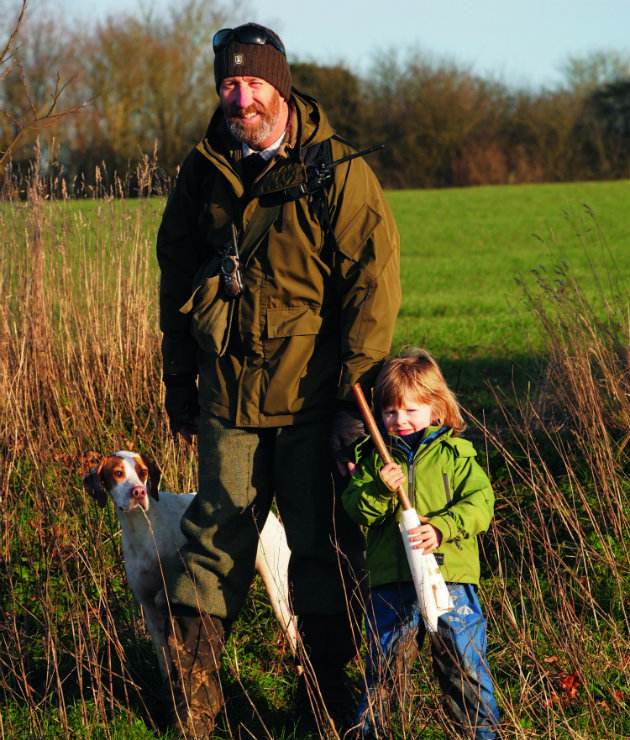
Rafael, Matt and rescue dog Holly, an English pointer which was shaping up nicely in the beating line
With the final horn blown to finish the day and to honour the quarry, everyone returned to the meet for a late lunch. Good company and good food are at the heart of this small shoot. Neither beaters nor pickers-up are paid, and many travel considerable distances to take part. The Germans, who had travelled the farthest, also declared their intention to come back next season, too. I wasn’t surprised.
Other shoots could learn lessons from the Grove
When I first started shooting there was no such thing as a shooting industry. You couldn’t buy a day’s shooting even if you wanted to. Today anyone with enough cash can purchase as much shooting as they can afford. Whether this is a good thing is debatable: I dislike working my dogs for people who might have thick wallets, but who have little or no knowledge of the shooting field, its tradition and etiquette, let alone the quarry they are pursuing.
This explains why I found my visit to the Grove so refreshing. Though it has five regular Guns, shoot captain Miles Malone ensures that it is a relaxed, friendly affair, and about as far from a typical commercial operation as you can get. It is run completely by unpaid volunteers, all of whom help with such jobs as feeding, predator control and dogging-in. The part-time keeper, Paul Newman, puts in a huge amount of effort simply because he loves doing it.
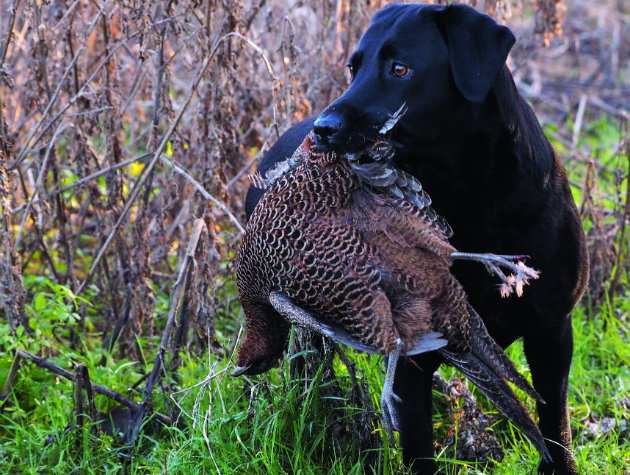
Labrador Tilly with a melanistic hen pheasant
There’s no pressure on Paul on shooting days “to get the bag”, a horrible term that has crept into shooting parlance. Everyone knows that he and his team of beaters are doing their very best. On the day of my visit the bag was 103 birds (54 cocks, 39 hens, two woodcock, six red-legged partridges, one woodpigeon and a jay). The total number of shots fired was 382. Counting the shots were two young girls, Lucy and Beth, who turn out on every shooting day. While they are beating, their mother, Jenny, stays behind in the barn with the slow cookers, preparing the feast for the assembled company. On the day of my visit it was baked potato with chilli, followed by apple crumble and an assortment of home-made cakes. Miles’s parents help with supplying the food and even planting the covercrops.
The shoot is proud of the contribution it makes to the local community and to conservation. It works to help its population of wild grey partridges, while the crowds of finches that flushed from the covercrops showed that it’s not just gamebirds that benefit from its efforts. We could do with more shoots like the Grove.
Related Articles
Get the latest news delivered direct to your door
Subscribe to Shooting Times & Country
Discover the ultimate companion for field sports enthusiasts with Shooting Times & Country Magazine, the UK’s leading weekly publication that has been at the forefront of shooting culture since 1882. Subscribers gain access to expert tips, comprehensive gear reviews, seasonal advice and a vibrant community of like-minded shooters.
Save on shop price when you subscribe with weekly issues featuring in-depth articles on gundog training, exclusive member offers and access to the digital back issue library. A Shooting Times & Country subscription is more than a magazine, don’t just read about the countryside; immerse yourself in its most authoritative and engaging publication.





